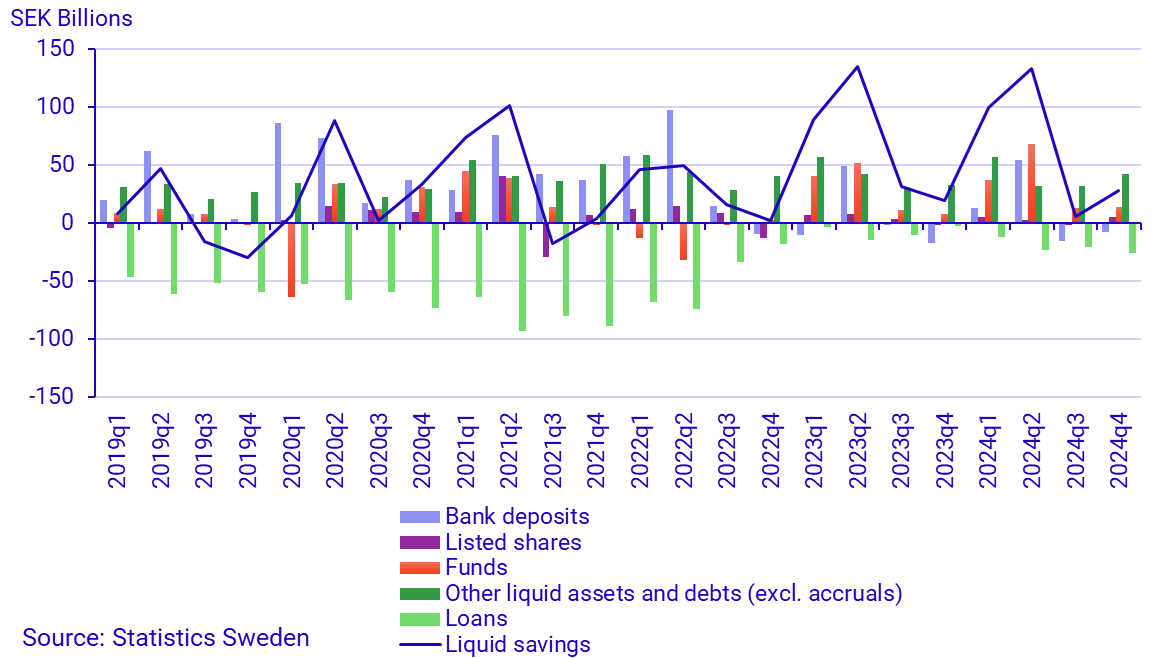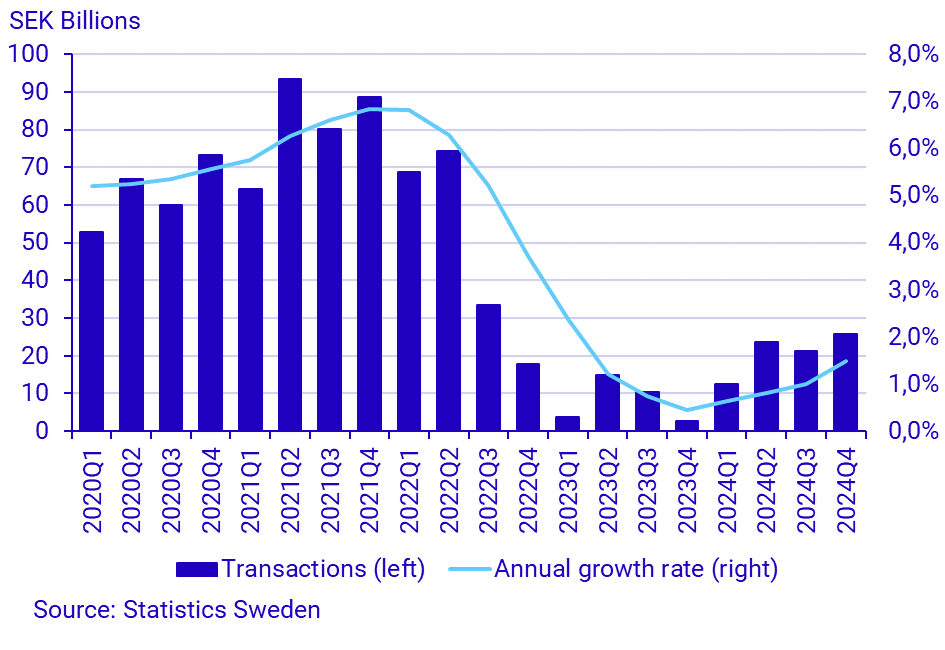Savings Barometer, fourth quarter 2024
Househould liquid savings increases
Statistical news from Statistics Sweden and Swedish Financial Supervisory Authority 2025-02-20 8.00
Household liquid savings amounted to SEK 28 billion at the end of the fourth quarter of 2024. This is SEK 9 billion higher compared to the same period last year. At the same time, the annual growth rate of household loans was 1,5 percent.
At the end of the quarter, household new savings in liquid assets amounted to SEK 53 billion. At the same time, loans increased by SEK 26 billion. The liquid savings thus amounted to SEK 28 billion.
Household saving in shares, funds and deposits
During the quarter, households net purchased listed shares for SEK 5 billion and funds to a value of SEK 14 billion.
Households net deposits amounted to SEK 8 billion, which was less than the same period last year where it amounted to SEK 17 billion.

Household loans and annual growth rate
At the end of the quarter, household total loans amounted to SEK 5 309 billion, giving an annual growth rate of 1,5 percent.
Household net borrowing during the quarter amounted to SEK 26 billion. This is an increase of SEK 23 billion compared to the same period last year.

Definitions and explanations
Liquid savings are calculated as the difference between transactions in financial assets and liabilities excluding accruals (tax accruals, occupational pensions, and other insurance technical reserves). The statistics are presented at current prices and do not take inflation into account.
In the Savings Barometer, household liquid savings are a key measure of household savings in financial assets because it reflects household financial decisions in the short term. Liquid savings include currency, deposits, bonds, directly owned shares, funds, private insurance savings and other financial assets. In addition to this, tenant ownership rights and holiday homes abroad are also included. These instruments are usually not considered liquid but are included to be able to deduct liabilities from savings.
In addition to loans from banks and housing institutions, household total loans also include student loans and other loans (which are loans to financial corporations that are not classified as banks or housing institutions). Household net borrowing is calculated as the difference between new loans and amortization.
Household ownership of tenant-owned apartments is a financial asset and is included in the Savings Barometer. However, single-family homes with ownership rights are not included as it is a real asset. Information on household total assets in dwellings can be found in the publication National wealth.
The electricity subsidy affects the liquid savings when the payment is made, but it affects the financial savings when the decision on the electricity subsidy is made. This means that first electricity subsidy that was paid out during the first quarter of 2023 affected liquid savings by SEK 17 billion. But it has no impact on total financial savings. The second electricity subsidy, which was decided on in March, affects liquid savings by SEK 9.6 billion in the second quarter of 2023.
No major revisions or methodological changes are published in the Savings Barometer. These are instead published in the Financial Accounts where more time for calculations and reconciliations with other sectors is available and revision documentation is published. However, minor revisions may occur because of, for example, revised primary statistics.
In connection with the release of the Savings Barometer for the first quarter of 2023, the time series will be updated starting from the first quarter of 2017 with the revisions introduced in the Financial accounts release on 16 March 2023.
More detailed descriptions of major revisions are described in the news from the Financial Accounts statistics:
Financial accounts, quarterly and annual
Further information: National wealth
In connection with the publication of Financial Accounts, the National Wealth Report is also published, which contains annual data on both real and financial assets. The financial assets and liabilities are derived from the Financial Accounts and are thus consistent with the values published in the Financial Accounts.
For more information, see:
National Wealth and National Balance Sheets (pdf) (in Swedish)
Statistical database;
Next publishing will be
2025-05-15 at 08:00.
Statistical Database
More information is available in the Statistical Database
Feel free to use the facts from this statistical news but remember to state Source: Statistics Sweden.
